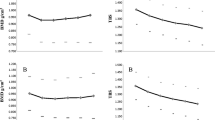Abstract
Bone and mineral metabolism has been reported to affect the development of the ossification of the posterior longitudinal ligament (OPLL). The aim of this study was to compare bone mineral densities (BMD) and rate of osteoporosis between cervical OPLL and a matched control group. We also investigated the correlation of BMD with the number of cervical spine levels involved with OPLL. From 1999 to August 2011, 178 patients with cervical OPLL underwent dual-energy X-ray absorptiometry (DXA) at our institute. The control group was age-, sex-, and body mass index (BMI)–matched with the OPLL group on a 1:1 basis. BMD was measured at the lumbar spine (L1–L4), femoral neck, and total femur using DXA. Age, sex, and BMI were the same in the OPLL and control groups. BMDs of the OPLL and control groups were significantly different in the lumbar spine, femoral neck, and total femur (p = 0.0001, 0.0001, 0.009, respectively). Rates of osteopenia and osteoporosis were lower in the OPLL than in the control group according to lumbar spine and femoral neck DXA (p = 0.01, 0.03, respectively). A positive correlation was observed between lumbar spine BMD and the number of cervical spine levels involved with OPLL (p = 0.004).


Similar content being viewed by others
References
Saetia K, Cho D, Lee S, Kim DH, Kim SD (2011) Ossification of the posterior longitudinal ligament: a review. Neurosurg Focus 30(3):E1
Tsuyama N (1984) Ossification of the posterior longitudinal ligament of the spine. Clin Orthop Relat Res 184:71–84
Matsui H, Yudoh K, Tsuji H (1996) Significance of serum levels of type I procollagen peptide and intact osteocalcin and bone mineral density in patients with ossification of the posterior longitudinal ligaments. Calcif Tissue Int 59(5):397–400
Tsukahara S, Ikeda R, Goto S, Yoshida K, Mitsumori R, Sakamoto Y, Tajima A, Yokoyama T, Toh S, Furukawa KI, Inoue I (2006) Tumour necrosis factor alpha-stimulated gene-6 inhibits osteoblastic differentiation of human mesenchymal stem cells induced by osteogenic differentiation medium and BMP-2. Biochem J 398:595–603
Goto K, Yamazaki M, Tagawa M, Goto S, Kon T, Moriya H, Fujimura S (1998) Involvement of insulin-like growth factor I in development of ossification of the posterior longitudinal ligament of the spine. Calcif Tissue Int 62(2):158–165
Hirai N, Ikata T, Murase M, Morita T, Katoh S (1995) Bone mineral density of the lumbar spine in patients with ossification of the posterior longitudinal ligament of the cervical spine. J Spinal Disord 8(5):337–341
Yamauchi T, Taketomi E, Matsunaga S, Sakou T (1999) Bone mineral density in patients with ossification of the posterior longitudinal ligament in the cervical spine. J Bone Miner Metab 17(4):296–300
Morio Y, Yamamoto K, Kishimoto H, Hagino H, Kuranobu K, Kagawa T (1993) Bone mineral density of the radius in patients with ossification of the cervical posterior longitudinal ligament. A longitudinal study. Spine (Phila Pa 1976) 18(16):2513–2516
Kanis JA, Melton LJ 3rd, Christiansen C, Johnston CC, Khaltaev N (1994) The diagnosis of osteoporosis. J Bone Miner Res 9(8):1137–1141
Matsunaga S, Sakou T (2012) Ossification of the posterior longitudinal ligament of the cervical spine: etiology and natural history. Spine (Phila Pa 1976) 37(5):E309–E314
Kawaguchi Y, Urushisaki A, Seki S, Hori T, Asanuma Y, Kimura T (2011) Evaluation of ossification of the posterior longitudinal ligament by three-dimensional computed tomography and magnetic resonance imaging. Spine J 11(10):927–932
Hasegawa K, Homma T (1997) Morphologic evaluation and surgical simulation of ossification of the posterior longitudinal ligament using helical computed tomography with three-dimensional and multiplanar reconstruction. Spine (Phila Pa 1976) 22(5):537–543
Chiba K, Kato Y, Tsuzuki N, Nagata K, Toyama Y, Iwasaki M, Yonenobu K (2005) Computer-assisted measurement of the size of ossification in patients with ossification of the posterior longitudinal ligament in the cervical spine. J Orthop Sci 10(5):451–456
Lee DC, Campbell PP, Gilsanz V, Wren TA (2009) Contribution of the vertebral posterior elements in anterior–posterior DXA spine scans in young subjects. J Bone Miner Res 24(8):1398–1403
Okada S, Maeda T, Saiwai H, Ohkawa Y, Shiba K, Iwamoto Y (2010) Ossification of the posterior longitudinal ligament of the lumbar spine: a case series. Neurosurgery 67(5):1311–1318
Eun JP, Ma TZ, Lee WJ, Kim MG, Yoo MJ, Koh EJ, Choi HY, Kwak YG (2007) Comparative analysis of serum proteomes to discover biomarkers for ossification of the posterior longitudinal ligament. Spine (Phila Pa 1976) 32(7):728–734
Jergas M, Breitenseher M, Gluer CC, Yu W, Genant HK (1995) Estimates of volumetric bone density from projectional measurements improve the discriminatory capability of dual X-ray absorptiometry. J Bone Miner Res 10(7):1101–1110
Marshall D, Johnell O, Wedel H (1996) Meta-analysis of how well measures of bone mineral density predict occurrence of osteoporotic fractures. BMJ 312(7041):1254–1259
Yu W, Gluer CC, Grampp S, Jergas M, Fuerst T, Wu CY, Lu Y, Fan B, Genant HK (1995) Spinal bone mineral assessment in postmenopausal women: a comparison between dual X-ray absorptiometry and quantitative computed tomography. Osteoporos Int 5(6):433–439
Schlenker RA, VonSeggen WW (1976) The distribution of cortical and trabecular bone mass along the lengths of the radius and ulna and the implications for in vivo bone mass measurements. Calcif Tissue Res 20(1):41–52
Fitzpatrick LA, Dabrowski CE, Cicconetti G, Gordon DN, Fuerst T, Engelke K, Genant HK (2012) Ronacaleret, a calcium-sensing receptor antagonist, increases trabecular but not cortical bone in postmenopausal women. J Bone Miner Res 27(2):255–262
Acknowledgment
This study was supported by a National Research Foundation of Korea grant funded by the Korean government (2012-0000996). Statistical consultation was provided by the Seoul National University Medical Research Collaborating Center (2011-0149).
Author information
Authors and Affiliations
Corresponding author
Additional information
The authors have stated that they have no conflict of interest.
Rights and permissions
About this article
Cite this article
Sohn, S., Chung, C.K. Increased Bone Mineral Density and Decreased Prevalence of Osteoporosis in Cervical Ossification of the Posterior Longitudinal Ligament: A Case–Control Study. Calcif Tissue Int 92, 28–34 (2013). https://doi.org/10.1007/s00223-012-9662-x
Received:
Accepted:
Published:
Issue Date:
DOI: https://doi.org/10.1007/s00223-012-9662-x




